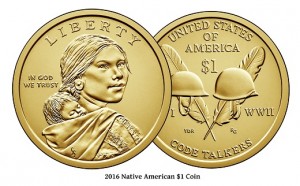On the Immense Popularity of Sacagawea Dollars in Ecuador
There is, in South America, a curious numismatic trend that challenges our assumptions of what is marketable and what is not. See, the one-dollar coin has historically been a hard sell in the United States. Its incarnations, like the Susan B. Anthony dollar or the Sacagawea dollar, spent very little time in circulation before the American public grew tired of these coins.
As far as commercial use, many had assumed the coins dead, but the Sacagawea dollar has experienced a rebirth in Ecuador.
The late 1990’s saw Ecuador’s economic infrastructure crumble. Seventy percent of their banks and lenders closed. Economic activity slowed by almost 10%. Unemployment neared 20%, underemployment 55%. The value of the nation’s currency, the sucre, fell by almost 200%. To put things into perspective, remember that in 1970 one could exchange a single American dollar for 25 sucres; by 1998 one American dollar was the equivalent of 25,000 sucres.
To combat this precipitous fall and repay the depositors of failed banks, the government desperately increased the money supply by a rate of 170% annually, which in turn made the sucre worth even less. Hyperinflation soon became a reality.
President Mahuad declared for the fourth time in his 18-month tenure a state of emergency. Mahuad demanded members of his own cabinet resign. His approval rating fell from 60% to a lowly 6%, and strikes by public-sector employees threatened to turn the country upside down.
Mahuad saw dollarization as the only to way to prevent implosion, and while he was run out of office in 2000, his controversial plan was still set into motion.

An estimated 149.1 million United States dollar coins have been sent to Ecuador since 2002. Paper dollars do find their way to Ecuador but some view these bills with suspicion.
“Nobody wants those things,” said Byron Imbaqo, an employee at the Rio Intag cafe in the Ecuadorean capital of Quito, “because you think they might be fake.” Imbaqo brings in about $120 a day in tips, much of it in dollar coins. By the end of a week, he’ll have received only one paper bill.
For others the draw of the dollar coin is in its weighty feel. The pieces feel like something that is not to be readily disposed of, something to be judiciously spent. Something real and not just representative.
“Nobody wants to carry around dollar bills,” said David Maji, one of Quito’s many taxi drivers. “If I ever get a bill, I get rid of it as fast as I can.”
There is a third component, though. Some Ecuadorians simply feel a sense of kinship with the figure portrayed on coins.
“I always thought she was one of us,” said Quito resident Luzmila Mita. “It took me a long time to know she was from up there [in North America].”
 Sacagawea is a revered figure in American history. The Shoshone woman was pivotal in the Lewis and Clark expeditions, guiding the party through unfamiliar terrain during their exploration of the newly purchased western territories.
Sacagawea is a revered figure in American history. The Shoshone woman was pivotal in the Lewis and Clark expeditions, guiding the party through unfamiliar terrain during their exploration of the newly purchased western territories.
When in 1998, the decision was made to create coins bearing her likeness, artist Glenna Goodacre traveled to Idaho to visit the Native American Shoshone tribe where she hoped to find a modern day Sacagawea. Randy’L Teton, a college student at the time, was chosen for her striking resemblance to the historical figure.
The U.S. Mint charged full speed ahead with its promotion of the coins. They commissioned a countrywide tour, which Teton was invited to join, in 2000. At one point, even Honey Nut Cheerios was including the pieces in select boxes of cereal. Despite these efforts, the U.S Mint was availed little, the American public would not bite.
“American people prefer the dollar bill that they can fold and put into their pants pocket,” said Teton. “Even my own community never really showed the support for [the coin] that it should have.”
This was, perhaps at the time, particularly distressing for Teton as she takes pride in sharing the story of Sacagawea, but the history of Sacagawea has proven just as resilient as its subject. Today, Teton can take pride in the fact that the coin is not only used in Ecuador, but celebrated.
“If you’re telling me that Ecuadorians are fully utilizing the coin, I’m just so glad someone is using it,” said Teton.
The opinions and forecasts herein are provided solely for informational purposes, and should not be used or construed as an offer, solicitation, or recommendation to buy or sell any product.

